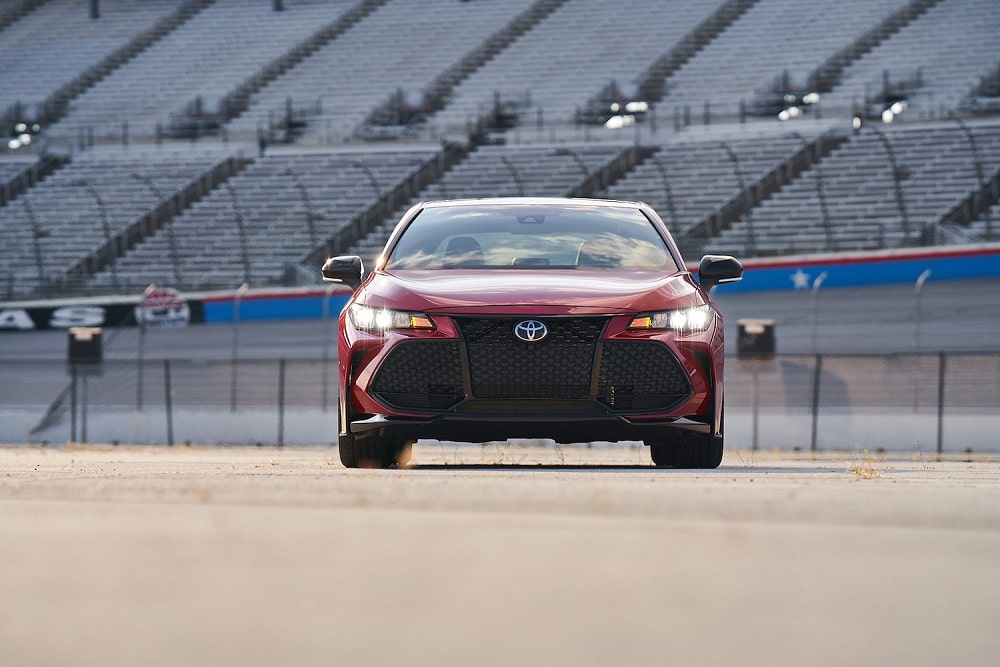Don’t tell Toyota, but someone in its Avalon division – the folks famous for Japanese Buicks – has the hots for a low, murdered-out Dodge Charger.
How else can you explain the 2020 Toyota Avalon TRD that rolled into my driveway last week, looking very red and bristling with parts possibly lifted from the Charger parts bin?
Heck, the Sunday trip to Luby’s may never be the same.
I’m tempted to blame The Virus and its “new norms” for the oddball Avalon TRD, but I think it is part of Toyota’s efforts to generate more excitement in its vehicles.
As Toyota and the industry know, you can sell a young man’s car to an old man, but it’s tough to sell even us oldies an old person’s car.
Low with obligatory black wheels and a great-sounding exhaust system, the niche Avalon TRD sported plenty of styling flourishes, but sort of backed it up with solid performance and surprisingly good driving dynamics.
TRD, incidentally, stands for Toyota Racing Development, the automaker’s respected in-house tuning division.
It must like a good challenge. After all, we’re talking Toyota Avalon here, one of the kings of boulevard cruisers.
You’ll be reminded of that every time you walk past the Avalon and its jarring, exaggerated grille plastered to the front like some Joker’s mask.
Blacked out and stretching from corner to corner, the hideously large grille appears to belong on a Caterpillar D9.
It contrasted with slender three-element headlamps that wrapped back into the fenders, signaling that better lines and curves await you.
A long, broad hood, for example, fit nicely with the huge doors and slightly slabbish sides on the full-size Avalon.
The 3,700-pound sedan – lowered more than a half-inch as part of the TRD mods – settled nicely on 255/40-tires wrapped around black, 19-inch TRD wheels.
Unfortunately, the styling changes didn’t stop there – and should have. TRD added tacky black aerodynamic spats to the lower rocker panels, as well as a deeper front-air dam and a glossy black lip-spoiler in back.
They kind of looked like grandpa in peace-symbol bell-bottoms.
However, don’t dismiss the Avalon TRD as another tape-and-spats job, as I did initially.
It’s not. Although Toyota made no changes to the Avalon’s 3.5-liter, 301-horsepower V-6, the full-size TRD feels firm, responsive and, yes, sporty.
The front-wheel-drive Avalon pulls strongly away from stops with a smooth, convincing shove and a rich moan from the TRD exhaust system.
Coupled to an 8-speed automatic, the torquey V-6 never strained to merge onto fast-moving freeways or cruise along highways – getting reasonable 25 mile-per-gallon overall fuel economy in the process.
Floor the big sedan, though, and the V-6 swells with rpm like a real performance car, winding past 6,000 rpm as it rushes to 60 mph in a respectable 6 seconds.
The quick-shifting 8-speed automatic helped, though it was occasionally hesitant in its downshifts.
Also a pleasant surprise – and how many of those do you get these days? – was the TRD’s handling, which felt more European than Asian.
The Avalon turned into corners eagerly, cleanly settling into them with minimal body lean, decent grip and good balance.
Moreover, it had one of the better combinations of ride and handling I’ve felt lately – slightly firm but with a full-size sedan’s fluid ability to absorb bumps and potholes.
A couple of times, I was tempted to check the badging just to confirm that this was indeed an Avalon.
Like the exterior, the Avalon’s interior felt pretty busy with various lines scampering across the plastic dashboard and door-panels and seeming a bit out of place in a $46,000 sedan.
A black upper dashboard rolled down to a mid-dash ledge that sort of softened the interior a bit with its slightly pliable, leather-like material.
Overshadowing both was a large black console and center stack with a touchscreen rising over the mid-dash.
Likewise, the door panels featured faux carbon-fiber strips at their tops with centers in the same pliable material as on the mid-dash.
Among the safety systems buried somewhere in all that material up front were active cruise-control, lane-departure alert and – one of my favorites – steering assist.
Still, the interior elicited few complaints from me because of the supportive black TRD sport seats with red stitching and, yes, red seatbelts.
If the “new norm” gets even tougher, you can even press the Avalon into Uber-duty with its Texas-sized back seat and expansive head-room. (You can transport people to get their take-out orders, I suppose.)
My Avalon had one significant option, a premium audio system with navigation system, $1,760.
As the Avalon suggests, Toyota is truly in transition these days. Fueled by everything it learned in developing the widely acclaimed new Supra coupe, Toyota can now work some magic on prosaic sedans like the Avalon.
It’s a good sign. Maybe the stylists could even say some special words over Toyota’s grilles.
2020 Toyota Avalon TRD Review
- What I liked most: The Avalon’s newfound ability to grow beyond its cushy cruiser image and deliver some performance and handling.
- What I would change: That controversial grille, which still looks like something conceived in an eighth-grade art class.
- MSRP: Base price of Avalon XLE, $35,875; as equipped, $46,394.
- Official color: Supersonic Red.
- Fuel economy: 22 miles per gallon in town, 31 on the highway and 25 mpg overall with filler on the left.
- Odometer reading when tested: 6,327 miles.
- Spare tire: Temporary compact.
- Weight: 3,704 pounds.
- Length-width-height: 196 inches long/73 inches wide/56 inches tall.
- Fuel-tank capacity: 15.8 gallons.
- Towing capacity: 1,000 pounds.
- 2020 Toyota Avalon in a few words: Still Toyota-strange, but an encouraging example of the performance and handling that Big T can summon when it wants.
- Warranty: Three-year, 36,000-mile overall warranty and five-year, 60,000-mile powertrain protection.
- Final assembly location: Georgetown, Ky.
- Manufacturer’s website: www.toyota.com
- Up next: 2020 Honda CR-V Touring

